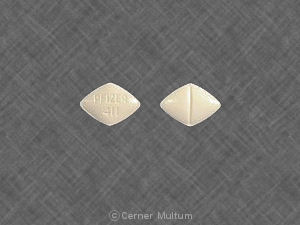Glucotrol Dosage
Generic name: GLIPIZIDE 5mg
Dosage form: tablet
Drug class: Sulfonylureas
Medically reviewed by Drugs.com. Last updated on May 29, 2023.
There is no fixed dosage regimen for the management of diabetes mellitus with GLUCOTROL or any other hypoglycemic agent. In addition to the usual monitoring of urinary glucose, the patient's blood glucose must also be monitored periodically to determine the minimum effective dose for the patient; to detect primary failure, i.e., inadequate lowering of blood glucose at the maximum recommended dose of medication; and to detect secondary failure, i.e., loss of an adequate blood-glucose-lowering response after an initial period of effectiveness. Glycosylated hemoglobin levels may also be of value in monitoring the patient's response to therapy.
Short-term administration of GLUCOTROL may be sufficient during periods of transient loss of control in patients usually controlled well on diet.
In general, GLUCOTROL should be given approximately 30 minutes before a meal to achieve the greatest reduction in postprandial hyperglycemia.
Initial Dose
The recommended starting dose is 5 mg, given before breakfast. Geriatric patients or those with liver disease may be started on 2.5 mg.
Titration
Dosage adjustments should ordinarily be in increments of 2.5–5 mg, as determined by blood glucose response. At least several days should elapse between titration steps. If response to a single dose is not satisfactory, dividing that dose may prove effective. The maximum recommended once daily dose is 15 mg. Doses above 15 mg should ordinarily be divided and given before meals of adequate caloric content. The maximum recommended total daily dose is 40 mg.
Maintenance
Some patients may be effectively controlled on a once-a-day regimen, while others show better response with divided dosing. Total daily doses above 15 mg should ordinarily be divided. Total daily doses above 30 mg have been safely given on a b.i.d. basis to long-term patients.
In elderly patients, debilitated or malnourished patients, and patients with impaired renal or hepatic function, the initial and maintenance dosing should be conservative to avoid hypoglycemic reactions (see PRECAUTIONS section).
Patients Receiving Insulin
As with other sulfonylurea-class hypoglycemics, many stable non-insulin-dependent diabetic patients receiving insulin may be safely placed on GLUCOTROL. When transferring patients from insulin to GLUCOTROL, the following general guidelines should be considered:
- For patients whose daily insulin requirement is 20 units or less, insulin may be discontinued and GLUCOTROL therapy may begin at usual dosages. Several days should elapse between GLUCOTROL titration steps.
- For patients whose daily insulin requirement is greater than 20 units, the insulin dose should be reduced by 50% and GLUCOTROL therapy may begin at usual dosages. Subsequent reductions in insulin dosage should depend on individual patient response. Several days should elapse between GLUCOTROL titration steps.
During the insulin withdrawal period, the patient should test urine samples for sugar and ketone bodies at least three times daily. Patients should be instructed to contact the prescriber immediately if these tests are abnormal. In some cases, especially when patient has been receiving greater than 40 units of insulin daily, it may be advisable to consider hospitalization during the transition period.
Patients Receiving Other Oral Hypoglycemic Agents
As with other sulfonylurea-class hypoglycemics, no transition period is necessary when transferring patients to GLUCOTROL. Patients should be observed carefully (1–2 weeks) for hypoglycemia when being transferred from longer half-life sulfonylureas (e.g., chlorpropamide) to GLUCOTROL due to potential overlapping of drug effect.
When colesevelam is coadministered with glipizide ER, maximum plasma concentration and total exposure to glipizide is reduced. Therefore, GLUCOTROL should be administered at least 4 hours prior to colesevelam.
More about Glucotrol (glipizide)
- Check interactions
- Compare alternatives
- Reviews (10)
- Drug images
- Side effects
- During pregnancy
- Drug class: sulfonylureas
- Breastfeeding
Patient resources
Other brands
Professional resources
Other brands
Other formulations
Related treatment guides
Further information
Always consult your healthcare provider to ensure the information displayed on this page applies to your personal circumstances.

